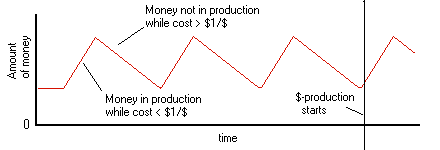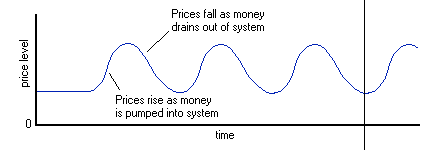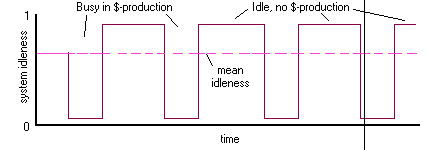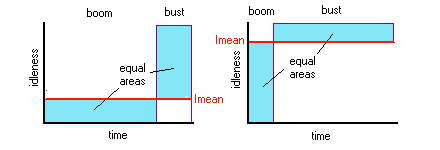
|
Prev: Money | Next: Simulation Model |

|

Static and Dynamic Economies
The trading systems considered so far have been in equilibrium, with stable prices, and stable patterns of exchange, and stable amounts of money in the system. Real economies, however, have varying prices, varying patterns of exchange, and varying amounts of money in them.
In static economies, in which the technology doesn't change much, and the environmental conditions and resource availability doesn't change much either, there is likely to be a stable set of prices, and a stable mean social idleness, with individual idleness scattered around that mean, with some people more idle than others. Some people will be monopoly land-owners or monopoly money-producers or monopoly tool-makers of one sort or other. Everyone else will be in competitive trades of one sort or other, one baker competing with other bakers, one shoemaker competing with other shoemakers, and so on. And because monopolists of any sort can charge high prices without fear of competitors undercutting them, they will earn high incomes, and live more idle lives than others. In the competitive trades, however, the price of goods and of labour will be driven down towards their costs of production, and so the idleness of this larger competitive society will be correspondingly less. There will be something like a rich and idle aristocracy and a poor and busy peasantry.
The monopolists will jealously guard their monopolies against potential competitors. And most of their competitors will be found in the rich aristocracies of other countries, with whom they will be very often at war. For the monopolists will only ever be as rich as they have customers for their goods. And territorial expansion will be the only way to enlarge their customer base and increase their income. And such territorial expansion will entail war.
And nothing will change very much while technological evolution remains slow or static. And wherever there are monopolies, such evolution will always be slow or static, because, in the absence of competition. monopolists have no incentive to improve their products. And so such innovation as is possible will not be carried out by the aristocrats, nor by the toiling peasantry, but by an intermediate class of entrepreneurs. The aristocrats will have the idle time in which to innovate, but no incentive to do so. The peasantry will have the incentive to innovate, but will lack the idle time in which to try out new innovations. It will only be a relatively small intermediate group who will have both the incentive to innovate and so improve their lives, and also sufficient idle time in which to carry out innovative investigations. And in this they may very often need the patronage of the more enlightened and far-sighted members of the aristocracy.
 The innovators of new tools will initially have a monopoly on them, and so will charge the highest prices. This will attract competitors, who will produce a cheaper product or a higher value product, and prices of the new tool will fall towards costs. Over time, as the new tool is improved and perfected, the value of the tool will generally rise, and the production costs will fall. Eventually, the new technology will be in turn supplanted by further new technologies, and demand for it will fall.
The innovators of new tools will initially have a monopoly on them, and so will charge the highest prices. This will attract competitors, who will produce a cheaper product or a higher value product, and prices of the new tool will fall towards costs. Over time, as the new tool is improved and perfected, the value of the tool will generally rise, and the production costs will fall. Eventually, the new technology will be in turn supplanted by further new technologies, and demand for it will fall.
As the new technology falls in price and becomes available to more people, its use will result in a small increase in social idleness. And this small increase in social idleness will provide the time for further innovation, and further increases in idleness, in an accelerating process.
At the same time, technologies rendered obsolete by new tools will fall out of use, and their manufacturers will switch product to some other product. The last producers of obsolete technologies will also be monopolists, selling at high prices. What had been a largely static system of producers making traditional tools in traditional ways will give way to an increasingly transient system in which the life cycle of new tools, from innovation to obsolescence, will become shorter and shorter.
With rising idleness, a secondary economy may make its appearance, selling idle-time-consuming luxuries and amusements. The size of the secondary economy will grow with rising idleness.
One Kind of Boom-and-Bust Cycle
Other forms of price instability are the result of poor regulation of, for example, of the supply of money
In a trading system which uses some commodity - such as gold - as money, ownership of a mint may look like a licence to print money. On the face of it, it would seem that someone who operates a mint can just print enough money, or strike enough coins, to buy whatever they want.
In practice, anyone who starts doing this will be pouring money into the trading system, and they will find that the prices of tools and labour will rise in response. And since the mint owner will be buying tools and labour to manufacture the money, at some point the cost of making a money unit will rise to one money unit - it will come to cost $1 to make a $1 coin. And beyond this point it will cost more than $1 to make $1, and the mint owner will lose money.
So when the cost of making $1 rises to $1, the mint shuts down. And at that point, money will cease to be pumped into the trading system, and will instead begin to drain out. It drains out because the money tool will be a useful tool of some sort or other which will be used for other purposes than exchange. And so as money gradually drains out of the system, the price of tools and labour will begin to fall. And at the same time, with less labour and tools being purchased, idleness will rise.
Eventually it will fall back to the point where the $-cost of making $s will return below $1/$, and the mint will start up production again.
The amount of money in the system will be a sawtooth wave, with production switching on and off. The price level will cycle up and down, with a price maximum some time after the mint has ceased production, and a price minimum sometime after the mint has restarted production. And as the mint buys in labour and materials, the idleness of the system will fall, and bounce back up to a high level when production stops again, cycling around the mean idleness of the system.



This is a cycle of boom and bust. It should be noted that this is primarily a 'boom' from the point of view of the mint proprietors rather than the rest of the trading system. During the 'boom' the mint proprietors grow rich, and the rest of the economy works for them as their labour and tools are bought.
During the boom, the mint manufactures coins, and uses these to buy labour and materials to make more coins, and money floods into the trading system, prices rise, and idleness falls. During the bust, money drains out of the system, prices fall, and idleness rises.
This cycle is driven entirely by the switching on and off of the money supply. If, instead of manufacturing money as fast as possible for a relatively short period, the mint manufactured and spent money at the same rate as it drained out of the system, the amount of money in the system would remain stable, and prices would neither rise nor fall, and idleness would remain stable at its mean level.
This cycle also corresponds roughly to the decades-long boom and bust cycles witnessed in real economies. During boom times, banks lend money to manufacturers, and prices rise, and everyone is kept busy. During busts, banks stop lending money, prices fall, and everyone falls relatively idle. This doesn't particularly matter if the increased idleness during busts is equally distributed across society. But if some people are completely idle, while others remain fairly busy, this unemployment will mean that idle people who wish to earn money are unable to do so.
This sort of cycle grows from an inability to regulate the supply of money. What is needed is a way of ensuring that there is enough money in the system to ensure that everyone can buy what they need, but not so much as to push prices upwards.
Cycle mark-space ratio
If the cycle alternates between zero idleness and complete idleness, then if booms cancel out busts, at high mean idleness (Imean) the length of the bust period is long relative to the boom duration, and at low mean idleness the length of the bust period is short relative to the boom period

This suggests that with rising idleness, boom periods will get shorter, and bust periods longer.


|
Prev: Money | Next: Simulation Model |

|